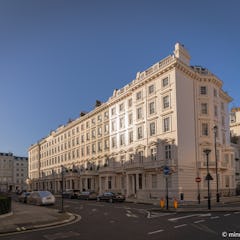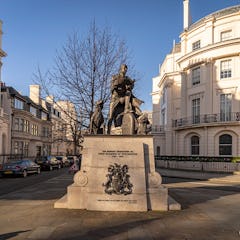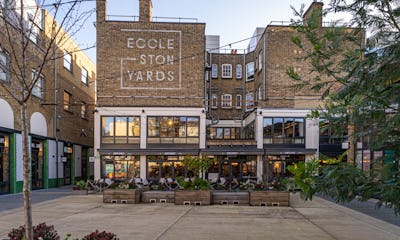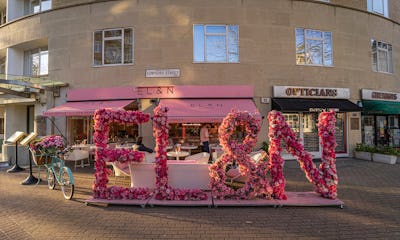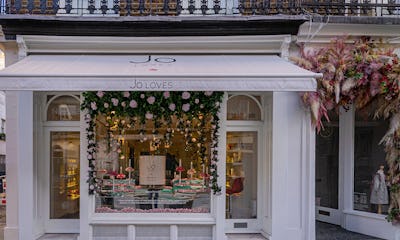History
Belgravia was established in the early 19th century as part of a broader plan by the Grosvenor family, especially Richard Grosvenor, the 2nd Marquess of Westminster, to develop lands owned by the family near central London. The area was previously known as Five Fields and mainly consisted of sparsely built countryside.
The name Belgravia originates from the Grosvenor family’s rural estate named Belgrave, located near Chester in northwest England. The family used the estate’s name to emphasise the new neighbourhood’s refined and traditional character.
Architecture
At the marquess’s commission, Belgravia’s design and construction were led by Thomas Cubitt, one of the most significant builders and architects of the Victorian era. Cubitt implemented a unified and orderly urban plan for Belgravia, characterised by expansive squares, straight streets, and harmonious façades.
Cubitt’s approach was pioneering: he not only designed the area but also built it using his workshops and contractors, which ensured high quality and visual cohesion. Thus arose one of London’s most elegant neighbourhoods, which attracted the upper class and diplomatic circles early on.
Belgravia’s architecture is renowned for its harmony and elegance. White stucco houses, ornate balconies, and lush courtyards create a cohesive and distinguished appearance. The buildings predominantly represent the early 19th-century Neoclassical style, with an emphasis on symmetry, proportion, and high-quality materials. Belgrave Square and Eaton Square are examples of Cubitt’s spacious, green squares, surrounded by impressive residential buildings. Many residential blocks also feature mews streets, originally home to stables for the grand houses, but now converted into charming residential lanes.
Landmarks
One of Belgravia’s key landmarks is St. Peter’s Church on Eaton Square, a neo-Gothic Anglican church that serves as the area’s spiritual and community hub. The church is popular not only for services but also as a venue for music and cultural events.
Another well-known site is Belgrave Square, one of London’s largest and most prestigious private squares. At its centre lies a green garden, surrounded by embassies, classic residential buildings, and sculptures, including statues of Simón Bolivar and Christopher Columbus, which reflect the area’s international character.
Eaton Square, in turn, is another of Belgravia’s defining squares—a broad, peaceful, and verdant space encircled by white terraced houses and embassy buildings. St Peter’s Church also sits along its perimeter.
Additionally, Chester Square is known for its notable former residents, including Margaret Thatcher. Its tranquil setting and green central area make it a cherished spot for both residents and passers-by.
Orange Square, located at the corner of Ebury Street and Pimlico Road, is a small but historically significant square. At its centre stands a statue of young Wolfgang Amadeus Mozart, unveiled in 1994, which references the composer’s stay in the area in 1764. Nearby, at 180 Ebury Street, there’s a blue plaque noting that Mozart composed his earliest symphonies there. The statue, sculpted by Philip Jackson, serves as a reminder of Belgravia’s cultural heritage in music.
Boutiques, Interiors, and Coffee Moments
Elizabeth Street is one of Belgravia’s most charming streets—a short but iconic thoroughfare known for its florists, designer shops, and photogenic atmosphere. It offers a peaceful environment for both locals and visitors with numerous charming restaurants and pubs. Along the street are many small luxury boutiques, stores specialising in bridal and occasion fashion, lifestyle shops, and designer florists, the most famous being Moyses Stevens, known for its colourful window displays.
The area also features numerous small, independent brands that focus on quality, craftsmanship, and visual appeal. The streetscape is particularly popular among photographers and social media influencers, especially in spring and during festive seasons, when shops decorate their façades extravagantly to match seasonal themes. One of the best-known spots is Peggy Porschen Cakes, a pastel-hued café that has become a go-to for both sweet-tooth enthusiasts and Instagram users. Opposite the café is Bayley & Sage, an independent food store offering fresh produce, cheeses, pastries, and select wines perfect for a high-quality picnic.
Eccleston Yards is a sheltered courtyard located between Belgravia and Victoria Station, which has evolved into a relaxed urban space combining design shops, yoga studios, galleries, and popular cafés such as Morena and Wild by Tart. It offers a tranquil setting for shopping and leisure between Belgravia and Victoria.
Motcomb Street is situated in the northeast part of Belgravia, near Lowndes Square. The street is known for its sophisticated atmosphere and small luxury boutiques and restaurants, such as Petrus by Gordon Ramsay. It has been home to various fashion brands and lifestyle stores.
The Pimlico Road Design District is located in the southern part of Belgravia, near Sloane Square and Victoria Underground Station. It’s one of London’s major hubs for interior design and craftsmanship, where traditional British craftsmanship meets contemporary design. The district features a diverse range of shops, including antique dealers, interior design stores, design studios, and textile shops. Notable names include Howe, Robert Kime, Paolo Moschino, Cox London, Rose Uniacke, and Modernity. Stores offering handmade fabrics, such as de Le Cuona, enrich the area. The district is also known for its annual cultural events, such as exhibitions and workshops during London Craft Week. Between shopping, visitors can relax in cosy cafés and restaurants, like Daylesford Organic and Wild by Tart, where high-quality food meets thoughtful interior design.
Famous Residents and Cultural History
Belgravia has long been home to influential figures from the worlds of politics, art, fashion, and music. The neighbourhood’s sophisticated atmosphere, quiet streets, and central location have attracted both British elites and international personalities since the 19th century.
Historically, some of its most famous residents include Margaret Thatcher, the United Kingdom’s first female Prime Minister, who lived on Chester Square after retiring, and the composer Wolfgang Amadeus Mozart, who stayed on Ebury Street as a child in 1764. Author Mary Shelley, creator of Frankenstein, also lived in Belgravia during the 1840s. The area has been home to many aristocrats, scientists, and cultural figures who have left their mark on London’s history.
From the world of music, composer Andrew Lloyd Webber has also lived in the area, known worldwide for his stage productions.
Belgravia combines peaceful residential living with curated cultural experiences. St. Peter’s Church on Eaton Square offers chamber music and choral concerts, while local art galleries, such as the Pontone Gallery and Osborne Studio Gallery, enrich the area’s cultural scene.
Events
Belgravia offers a surprisingly diverse calendar of events, with a strong focus on floral displays and craftsmanship traditions.
Belgravia in Bloom is an annual flower festival held in May, coinciding with the Chelsea Flower Show. The neighbourhood fills with spectacular floral installations created by shops, hotels, and cafés adorning their façades. The event attracts photographers and garden enthusiasts from all over London, often featuring themed workshops, competitions, and special offers.
As part of London Craft Week, the Pimlico Road Series brings international artisans and designers to the area. Newson’s Yard, located on Pimlico Road in Belgravia, is a design destination housed in London’s oldest timber yard, hosting five interior design shops and the Wildflowers restaurant surrounding a bright courtyard. The venue and its surroundings feature workshops, demonstrations, and discussions that highlight tradition, quality, and British aesthetics.
Hotels
Although Belgravia is primarily a residential area, it also offers several stylish boutique hotels:
The Goring (near Victoria Station): A hotel favoured by the royal family, known for traditional service and its garden. The Duchess of Cambridge, now the Princess of Wales, stayed at the hotel before her 2011 wedding, further cementing its royal reputation.
Eccleston Square Hotel (near Eccleston Yards): A charming boutique hotel located on historic Eccleston Square. It offers modern comforts and views over a beautiful garden.
The Lanesborough (technically on the Hyde Park Corner side but right on Belgravia’s edge): Luxury accommodation with Michelin-starred dining.
Practical Tips
The façades of Elizabeth Street, the parks of Belgrave Square, and the white townhouses provide excellent photography opportunities, especially in the morning or late afternoon light.
Summary
Belgravia is a hidden gem in the heart of London. It offers a tranquil contrast to the city’s busier districts, attracting those who seek architectural beauty, luxurious details, and a serene atmosphere.
